Current Sensor Fault-Tolerant Control Strategy for Speed-Sensorless Control of Induction Motors Based on Sequential Probability Ratio Test
Abstract
1. Introduction
2. Induction Motor Speed Estimation Method Based on EKF
3. Diagnosis of Current Sensor Fault
3.1. Theoretic Basis for Diagnosing Current Sensor Fault Based on SPRT
- (1)
- If , this current signal is a fault signal.
- (2)
- If , it continues to conduct data validation until criterion (1) is satisfied.
3.2. SPRT Enhanced Judgment Based on Sliding Window Function
4. Current Sensor Fault-Tolerant Control Algorithm
4.1. Principle of Current Sensor Fault-Tolerant Control in α-β Coordinate System
4.2. Suppressing Effect of Current Fault-Tolerant Control on DC Bias and Odd Harmonics
5. Analysis of Experimental Results
5.1. Test of Motor Speed Estimation Performance when Current Sensors Are Functioning Normally
5.2. Test of Motor Speed Estimation Performance under Condition of Current Sensor Malfunction
5.3. Comparison of Experimental Results between SPEKF-DSOGI and SEPLL
- (a)
- The open-circuit fault of the A-phase current sensor of the IM drives
- (b) The DC bias fault in the A-phase current sensor of the IM drives
- (c) The gain fault of the A-phase current sensor of the IM drives
- (d) The harmonic fault of the A-phase current sensor of the IM drives
6. Conclusions
- (1)
- The SPRT method was used to determine whether a current sensor had gone wrong. Then, the expression of the estimated value of the current innovation was modified based on the principle of the sliding window function, improving the accuracy of the SPRT in diagnosing current sensor faults.
- (2)
- A fault-tolerant strategy for inductive motors installed with two current sensors in two phases was proposed. A DSOGI was used to reconstruct faulty current information based on the concept of coordinate translation, providing accurate current information for the speed estimation scheme based on the EKF. When the current sensor of a certain phase experiences a fault, such as an open circuit, DC bias, or odd harmonic, the high-precision current sensor fault-tolerant control scheme for the IM speed-sensorless control system handles the fault and ensures the stable operation of the motor.
- (3)
- The results of a series of experiments conducted on a 3 kW induction motor experimental platform demonstrated that the proposed algorithm can ensure the accurate estimation of motor speed in various working conditions of inductive motors, including normal operation, an open circuit of the current sensor in a single phase, DC bias, gain, odd harmonics, etc.
Author Contributions
Funding
Data Availability Statement
Conflicts of Interest
References
- Chen, Y.X.; Xie, D.; Zuo, Y.; Chang, Y.; Ge, X.L. Current sensor fault tolerant control for induction motor with speed-sensorless based on SMO and SEPLL. In Proceedings of the 24th International Conference on Electrical Machines and Systems (ICEMS), Gyeongju, Republic of Korea, 31 October–3 November 2021; pp. 1988–1992. [Google Scholar]
- Wang, H.M.; Yang, Y.H.; Ge, X.L.; Zuo, Y.; Yue, Y.; Li, S.T. PLL- and FLL-based speed estimation schemes for speed-sensorless control of induction motor drives: Review and new attempts. IEEE Trans. Power Electron. 2022, 3, 3334–3356. [Google Scholar] [CrossRef]
- Chen, J.H.; Mei, J.; Yuan, X.; Zuo, Y.F.; Lee, C.H.T. Natural speed observer for nonsalient AC motors. IEEE Trans. Power Electron. 2022, 1, 14–20. [Google Scholar] [CrossRef]
- Wang, G.; Valla, M.; Solsona, J. Position sensorless permanent magnet synchronous machine drives—A review. IEEE Trans. Ind. Electron. 2020, 7, 5830–5842. [Google Scholar] [CrossRef]
- Wang, H.M.; Ge, X.L.; Liu, Y.C. Second-order sliding-mode MRAS observer-based sensorless vector control of linear induction motor drives for medium-low speed maglev applications. IEEE Trans. Ind. Electron. 2018, 12, 9938–9952. [Google Scholar] [CrossRef]
- Zhang, Y.P.; Zhang, G.Y.; Gao, F.T.; Liu, J. Research on anti-DC bias and high order harmonics of a fifth-order flux observer for IPMSM sensorless drive. IEEE Trans. Ind. Electron. 2022, 4, 3393–3406. [Google Scholar] [CrossRef]
- Wang, H.M.; Ge, X.L.; Yan, Y.; Liu, Y.C. Dual phase-locked loop-based speed estimation scheme for sensorless vector control of linear induction motor drives. IEEE Trans. Ind. Electron. 2020, 7, 5900–5912. [Google Scholar] [CrossRef]
- Woldegiorgis, A.T.; Ge, X.L.; Wang, H.M.; Hassan, M. A new frequency adaptive second-order disturbance observer for sensorless vector control of interior permanent magnet synchronous motor. IEEE Trans. Ind. Electron. 2021, 12, 11847–11857. [Google Scholar] [CrossRef]
- Zuo, Y.; Ge, X.L.; Zheng, Y.L.; Chen, Y.X.; Wang, H.M.; Woldegiorgi, A.T. An adaptive active disturbance rejection control strategy for speed-sensorless induction motor drives. IEEE Trans. Transp. Electrif. 2022, 3, 3336–3348. [Google Scholar] [CrossRef]
- Jlassi, I.; Estima, J.O.; El Khil, S.K.; Bellaaj, N.M.; Cardoso, A.J.M. A robust observer-based method for IGBTs and current sensors fault diagnosis in voltage-source inverters of PMSM drives. IEEE Trans. Ind. Appl. 2017, 3, 2894–2905. [Google Scholar] [CrossRef]
- Wu, C.Y.; Guo, C.Y.; Xie, Z.W.; Ni, F.L.; Liu, H. A signal-based fault detection and tolerance control method of current sensor for PMSM drive. IEEE Trans. Ind. Electron. 2018, 12, 9646–9657. [Google Scholar] [CrossRef]
- Chakraborty, C.; Verma, V. Speed and current sensor fault detection and isolation technique for induction motor drive using axes transforma tion. IEEE Trans. Ind. Electron. 2015, 3, 1943–1954. [Google Scholar] [CrossRef]
- Zuo, Y.; Ge, X.L.; Zhang, Y.; Chen, Y.X.; Xie, D.; Wang, H.M.; Woldegiorgi, A.T. Current Sensor Fault-Tolerant Control for Speed-Sensorless Induction Motor Drives Based on the SEPLL Current Reconstruction Scheme. IEEE Trans. Ind. Appl. 2023, 1, 845–856. [Google Scholar] [CrossRef]
- Yin, Z.G.; Li, G.Y.; Du, C.; Liu, J.; Sun, X.D. An adaptive speed estimation method based on strong tracking extended Kalman filter with least-square for induction motors. J. Power Electron. 2017, 1, 149–160. [Google Scholar] [CrossRef]
- Azizollah, G.; Mahmood, G.; Esmaeil, A.; Mohammad, J. Speed sensorless fault-tolerant control of induction motor drives against current sensor fault. Electr. Eng. 2021, 10, 1493–1513. [Google Scholar]
- Xiahou, K.S.; Wu, Q.H. Fault-tolerant control of doubly-fed induction generators under voltage and current sensor faults. Int. J. Electr. Power Energy Syst. 2018, 98, 48–61. [Google Scholar] [CrossRef]
- Wang, W.; Zeng, X.L.; Hua, W.; Wang, Z.; Cheng, M. Phase-shifting fault-tolerant control of permanent- magnet linear motors with single-phase current sensor. IEEE Trans. Ind. Electron. 2022, 69, 2414–2425. [Google Scholar] [CrossRef]
- Wang, W.; Feng, Y.A.; Shi, Y.; Cheng, M.; Hua, W.; Wang, Z. Fault-tolerant control of primary permanent- magnet linear motors with single phase current sensor for subway applications. IEEE Trans. Power Electron. 2019, 34, 10546–10556. [Google Scholar] [CrossRef]
- Adamczyk, M.; Orlowska-Kowalska, T. Postfault direct field-oriented control of induction motor drive using adaptive virtual current sensor. IEEE Trans. Ind. Electron. 2022, 69, 3418–3427. [Google Scholar] [CrossRef]
- Zhang, G.; Zhou, H.; Wang, G.; Li, C.; Xu, D. Current sensor fault tolerant control for encoder-less IPMSM drives based on current spacevector error reconstruction. IEEE J. Emerg. Sel. Top. Power Electron. 2020, 8, 3658–3668. [Google Scholar] [CrossRef]
- Liu, Z.H.; Nie, J.; Wei, H.L.; Chen, L.; Wu, F.M.; Lv, M.Y. Second order ESO-based current sensor fault-tolerant strategy for sensorless control of PMSM with B-phase current. IEEE/ASME Trans. Mechatron. 2022, 27, 5427–5438. [Google Scholar] [CrossRef]
- Verma, V.; Chakraborty, C.; Maiti, S.; Hori, Y. Speed sensorless vectorcontrolled induction motor drive using single current sensor. IEEE Trans. Energy Convers. 2013, 28, 938–950. [Google Scholar] [CrossRef]
- Chen, Z.; Huang, R.; Lin, Q.; Yu, X.; Dan, Z. Nonlinear Modeling and Control Strategy Based on Type-II T-S Fuzzy in Bi-Directional DC-AC Converter. Electronics 2024, 13, 1684. [Google Scholar] [CrossRef]
- Rong, N.N.; Wang, Z.S.; Zhang, H.G. Finite-Time Stabilization for Discontinuous Interconnected Delayed Systems via Interval Type-2 T–S Fuzzy Model Approach. IEEE Trans. Fuzzy Syst. 2019, 27, 249–261. [Google Scholar] [CrossRef]
- Molina-Santana, E.; Gonzalez-Montañez, F.; Liceaga-Castro, J.U.; Jimenez-Mondragon, V.M.; Siller-Alcala, I. Modeling and Control of a DC-DC Buck–Boost Converter with Non-Linear Power Inductor Operating in Saturation Region Considering Electrical Losses. Mathematics 2023, 11, 4617. [Google Scholar] [CrossRef]
- Yin, L.; Chen, Z.F.; Liu, J. Nonlinear Behavior Mechanism and Modeling Method of Wound SMD Inductor. Int. J. Numer. Model. 2023, 36, e3111. [Google Scholar] [CrossRef]
- Yao, Z.G.; Lan, H.G.; He, X.Y.; Deng, F.; Wang, C.S.; Lu, S.; Tang, Y. Nonlinear Inductor-Based Single Sensor Current Balancing Method for Interleaved DC–DC Converters. IEEE Trans. Power Electron. 2024, 39, 3996–4000. [Google Scholar] [CrossRef]
- Oliveri, A.; Lodi, M.; Storace, M. Nonlinear Models of Power Inductors: A Survey. Int. J. Circuit Theory Appl. 2022, 50, 2–34. [Google Scholar] [CrossRef]
- Zhang, R.Q.; Cheng, X.; Yang, L.Q. Flexible Energy Management Protocol for Cooperative EV-to-EV Charging. IEEE Trans. Intell. Transp. Syst. 2019, 20, 172–184. [Google Scholar] [CrossRef]
- Ali, S.; Xia, Y.; Khan, Z.; Ali, A.; Navid, Q.; Aurangzeb, K.; Anwar, M. Frequency regulation in interconnected power system through Enhanced beluga whale optimized flatness-based active disturbance rejection control. IEEE Access 2024, 12, 15348–15367. [Google Scholar] [CrossRef]
- Liang, J.H.; Wang, F.A.; Feng, J.W.; Zhao, M.Z. A Hierarchical Control of Independently Driven Electric Vehicles Considering Handling Stability and Energy Conservation. IEEE Trans. Intell. Veh. 2024, 9, 738–751. [Google Scholar] [CrossRef]

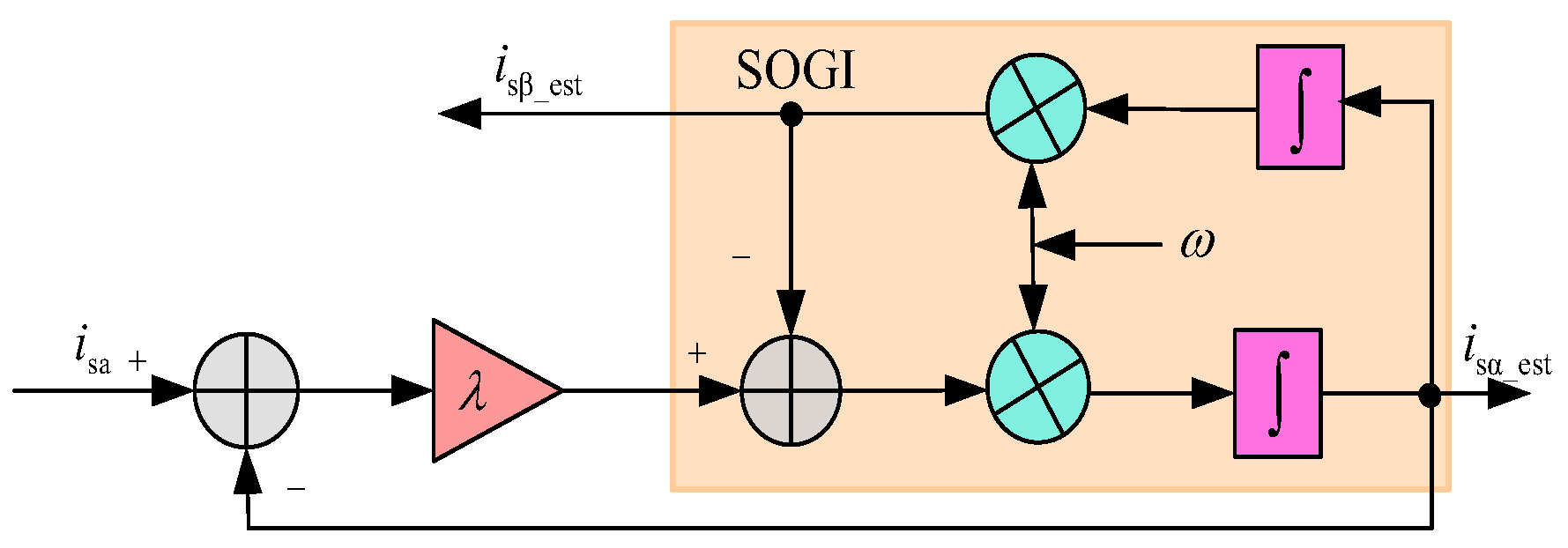

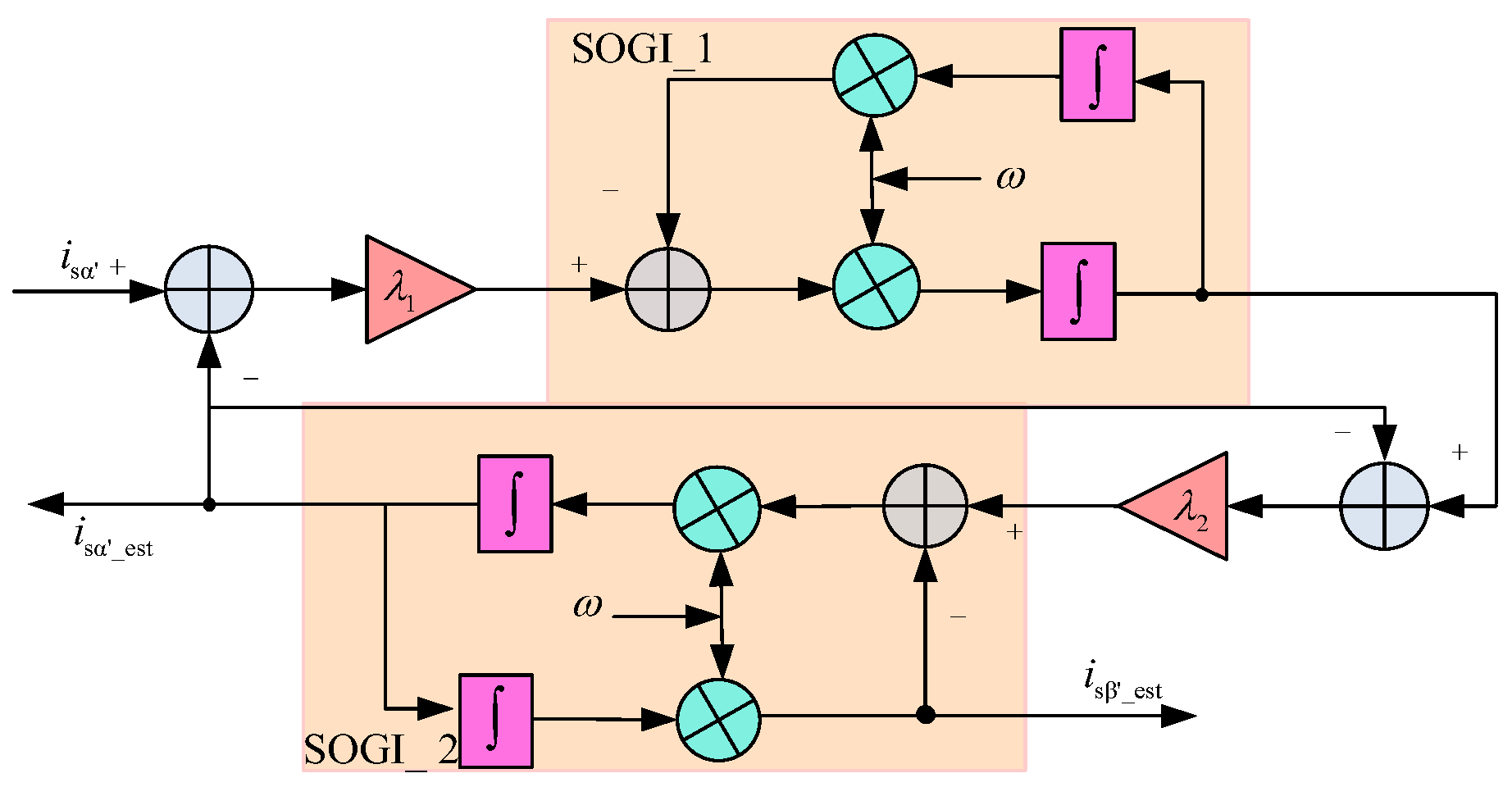

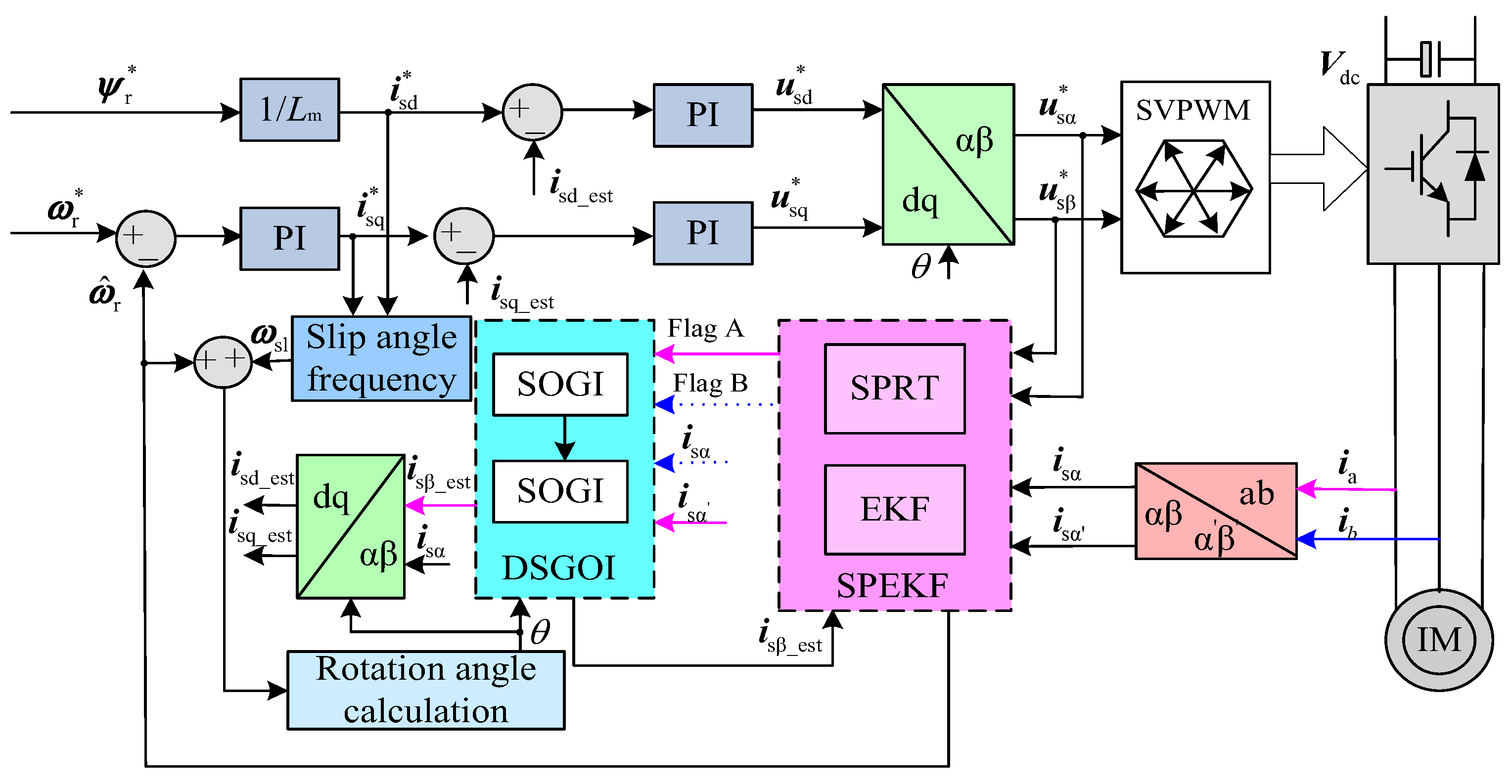


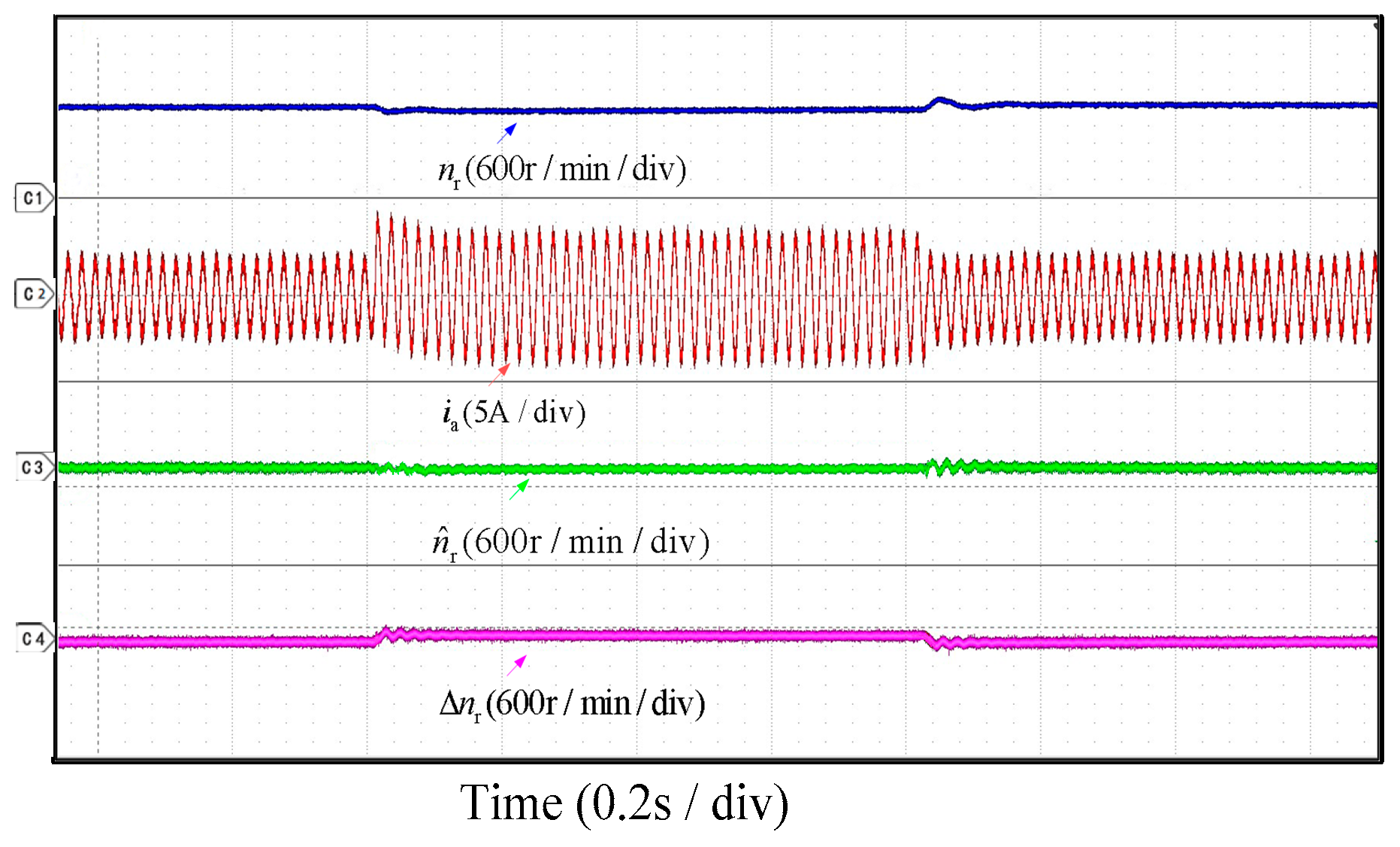
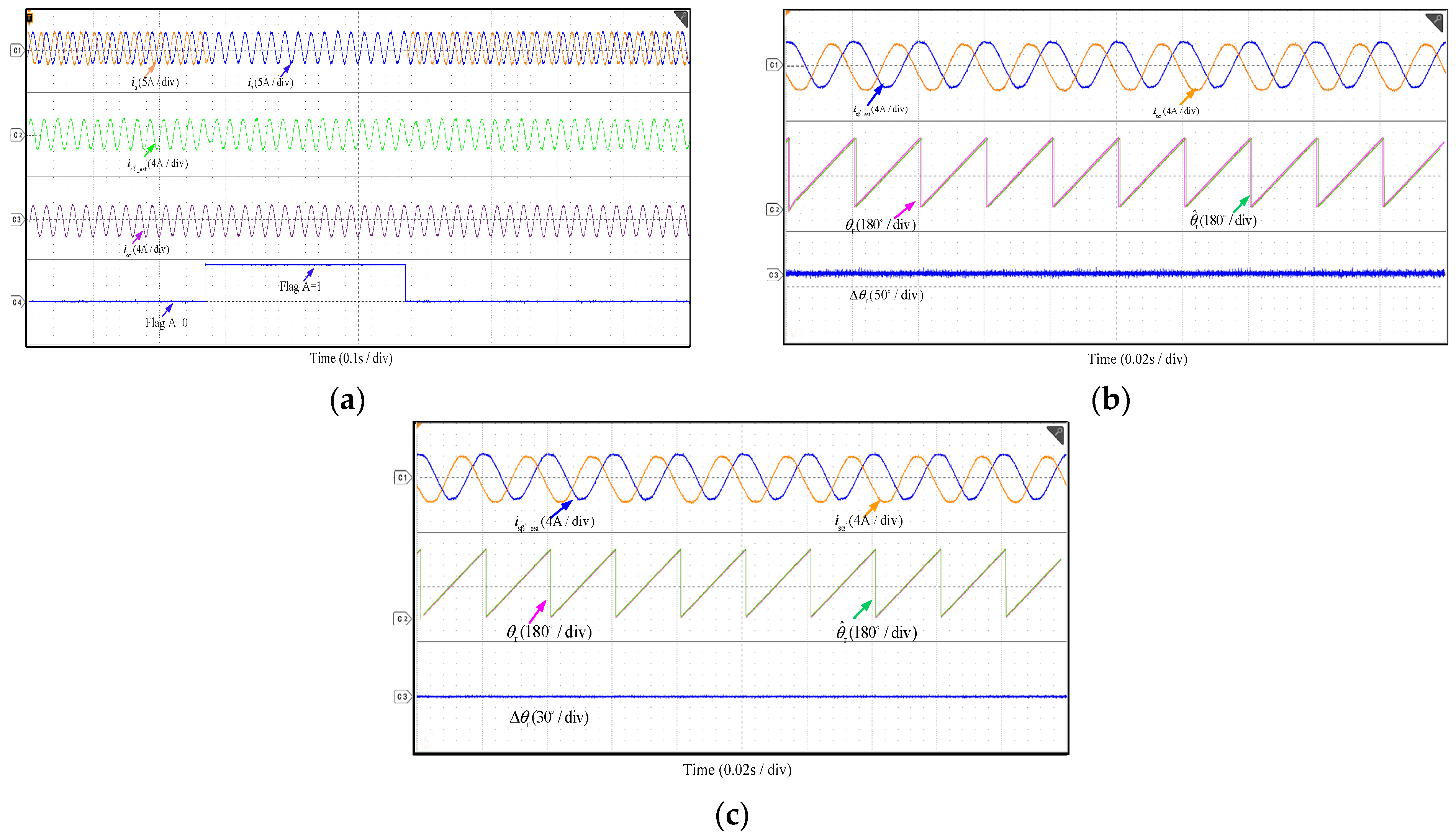
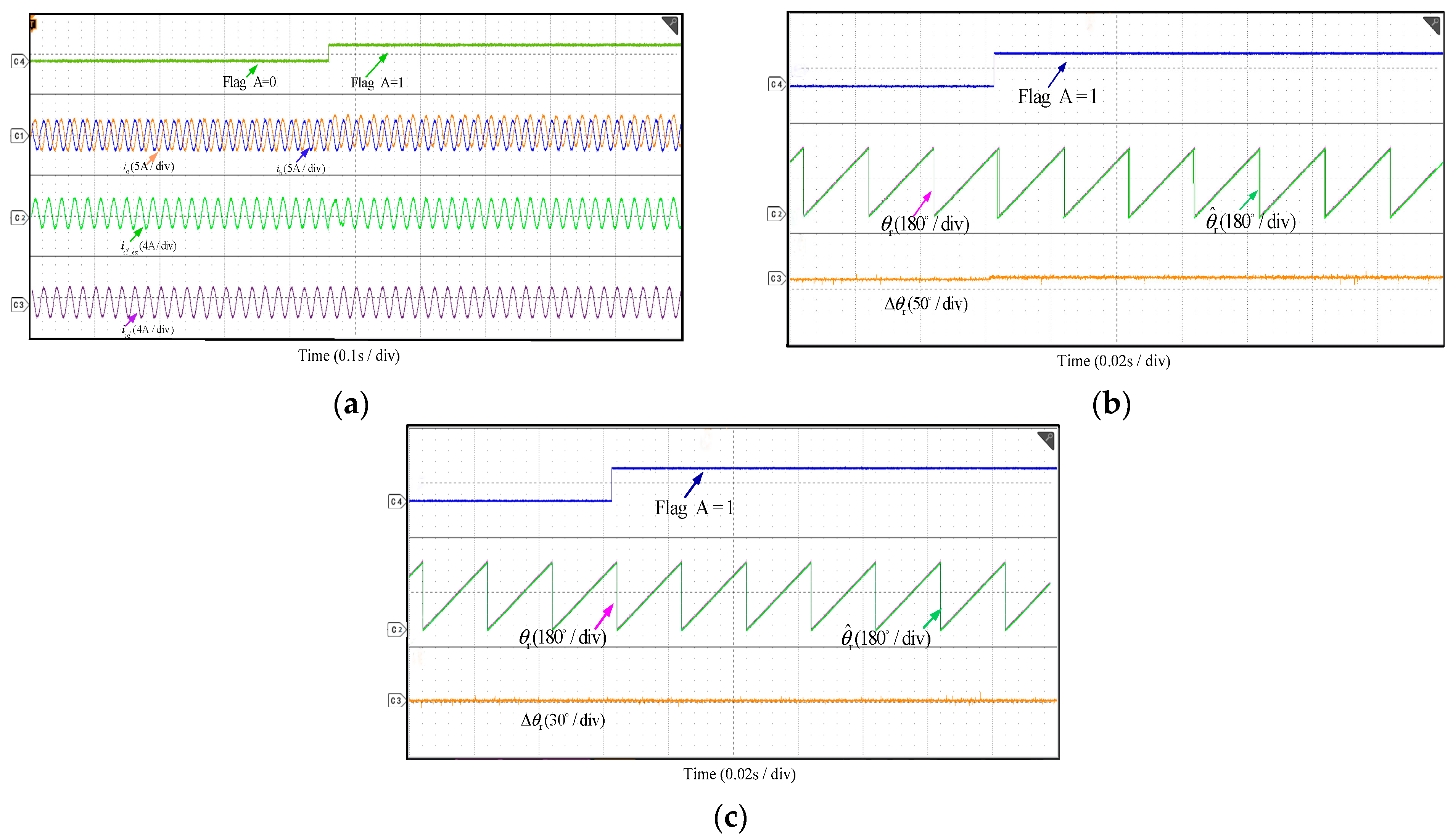





| m | Harmonic | |||
|---|---|---|---|---|
| 5th | 7th | 11th | 13th | |
| 1 | 25 | 31 | 39 | 42 |
| 2 | 50 | 62 | 78 | 84 |
| 3 | 75 | 93 | 116 | 129 |
| 4 | Inf | Inf | Inf | Inf |
| Name | Value | Name | Value |
|---|---|---|---|
| 3 kW | 3.127 Ω | ||
| 380 V | 3.55 Ω | ||
| 4.55 A | 0.165 H | ||
| 50 Hz | 0.171 H | ||
| 0.173 H | 3 | ||
| 0.006 H | 0.008 H |
Disclaimer/Publisher’s Note: The statements, opinions and data contained in all publications are solely those of the individual author(s) and contributor(s) and not of MDPI and/or the editor(s). MDPI and/or the editor(s) disclaim responsibility for any injury to people or property resulting from any ideas, methods, instructions or products referred to in the content. |
© 2024 by the authors. Licensee MDPI, Basel, Switzerland. This article is an open access article distributed under the terms and conditions of the Creative Commons Attribution (CC BY) license (https://creativecommons.org/licenses/by/4.0/).
Share and Cite
Zhang, F.; Gao, S.; Zhang, W.; Li, G.; Zhang, C. Current Sensor Fault-Tolerant Control Strategy for Speed-Sensorless Control of Induction Motors Based on Sequential Probability Ratio Test. Electronics 2024, 13, 2476. https://doi.org/10.3390/electronics13132476
Zhang F, Gao S, Zhang W, Li G, Zhang C. Current Sensor Fault-Tolerant Control Strategy for Speed-Sensorless Control of Induction Motors Based on Sequential Probability Ratio Test. Electronics. 2024; 13(13):2476. https://doi.org/10.3390/electronics13132476
Chicago/Turabian StyleZhang, Feige, Shesheng Gao, Wenjuan Zhang, Guo Li, and Chao Zhang. 2024. "Current Sensor Fault-Tolerant Control Strategy for Speed-Sensorless Control of Induction Motors Based on Sequential Probability Ratio Test" Electronics 13, no. 13: 2476. https://doi.org/10.3390/electronics13132476
APA StyleZhang, F., Gao, S., Zhang, W., Li, G., & Zhang, C. (2024). Current Sensor Fault-Tolerant Control Strategy for Speed-Sensorless Control of Induction Motors Based on Sequential Probability Ratio Test. Electronics, 13(13), 2476. https://doi.org/10.3390/electronics13132476






